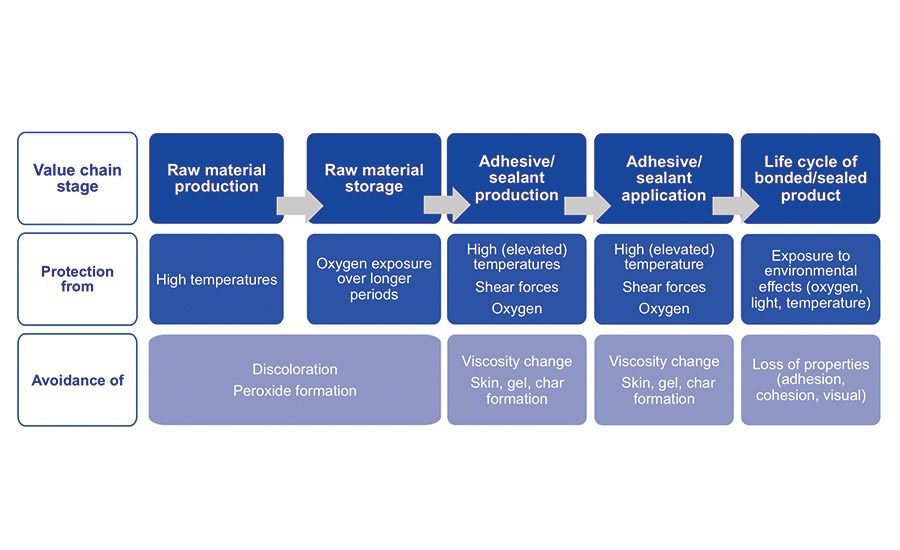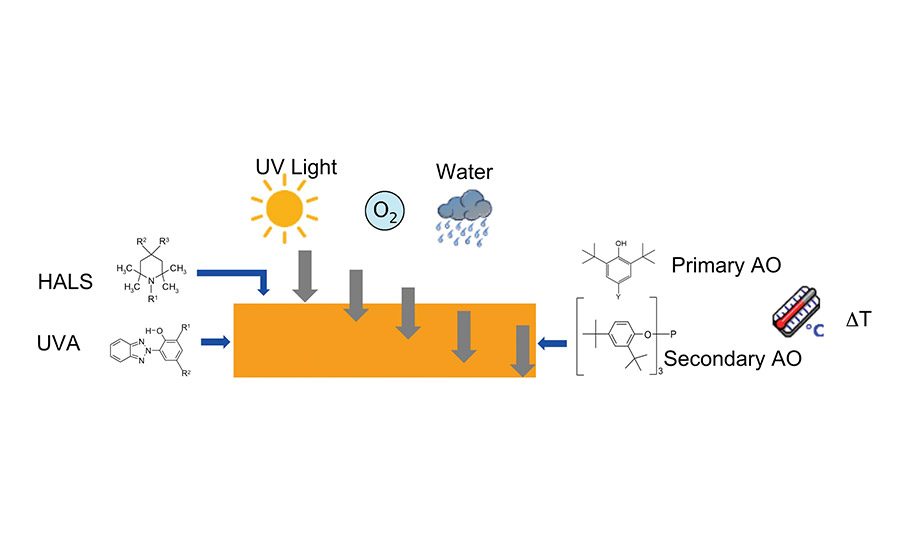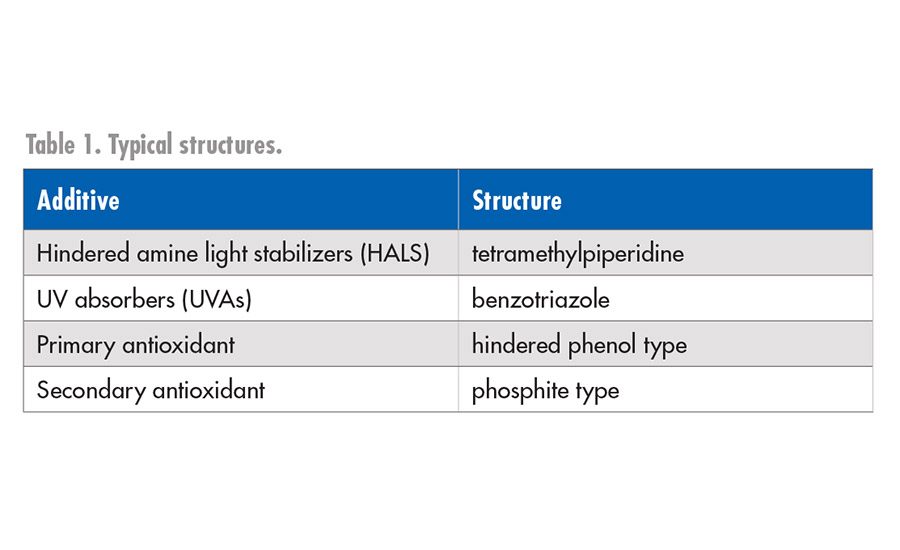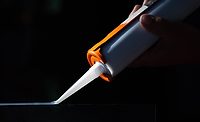How Do Stabilizers Improve Durability in Adhesives and Sealants Formulations?
Raw materials in adhesives and sealants formulations are often protected from degradation by suitable stabilizer packages or through appropriate packaging.

Figure 1. Overview of degradation causes and stabilization effects along the value chain.

Figure 2. Protection effects of antioxidants (AOs), UV absorbers (UVAs), and hindered amine light stabilizers (HALS).




Stabilizing additives such as antioxidants (AOs), ultraviolet (UV) absorbers, and hindered amine light stabilizers enable formulators to create durable adhesives and sealants, thereby extending the life of adhesively bonded goods. These high-performance products are key contributors to sustainable product development and help to promote the advancement of a circular economy.
Although often invisible, adhesives and sealants are part of our daily lives. They ensure that our food is packaged and advertised safely, that our houses are wind- and waterproof, and that our communication and mobility needs are served in safe and efficient ways. Thousands of everyday items such as mobile phones, washing machines, personal hygiene products, shoes, clothing, building products, batteries, automobiles, rail cars, ships, and airplanes are nowadays only practical due to the use of high-performing adhesives and sealants.
A broad range of chemistries and polymeric organic materials is required to cover the multitude of adhesive and sealant bonding parameters. Adhesive formulators have taken on the challenge and created the art of matching bonding performance requirements with products and application processes. Their core expertise lies in selecting chemistries, curing mechanisms, and raw materials and combining them to create a product that can be processed efficiently and economically in the respective application environment. Polymers and organic materials have an inherent tendency to change properties and degrade throughout their value chain—from manufacturing, processing, transportation, and storage right to end use (see Figure 1).
Stabilizing Formulations
Raw materials for adhesives and sealants are mainly based on different petrochemical feedstocks. In addition, many industrial raw materials are also derived from bio-based sources such as natural rubber or rosin ester tackifiers. All these organic materials are often protected from degradation by suitable stabilizer packages or through appropriate packaging.
For the complete and homogenous blending of components, the production of adhesives and sealants typically requires elevated temperatures and/or exhaustive mixing operations. Oxygen present in the process, together with the effects of temperature and the shear forces created by the equipment, leads to changes in material viscosity and promotes the formation of a skin, gel, or even char.
Antioxidants prevent thermally induced degradation of polymers in adhesives, sealants, and coatings during processing and under end-use conditions. Sterically hindered phenols act as primary antioxidants, stabilizing and/or deactivating oxygen-centered radicals. A combination with secondary phosphite- or thioester-based antioxidants that work in synergy with primary antioxidants is particularly effective. They react with the hydroperoxides that form, yielding inactive byproducts.
Sealants, coatings, and adhesives (depending on the application area) need to be protected from environmental exposure to oxygen and UV radiation, particularly during end use (see Figure 2). UV absorbers (UVAs) and hindered amine light stabilizers (HALS) guard against the loss of mechanical properties (e.g., adhesion and cohesion strength) and visual changes (e.g., color, haze, chalking). UVAs act as light filters and transform the absorbed energy into harmless heat. The thicker the material, the more efficient the absorber. In practice, this means that lower material layers are better protected than surface layers.
Individual UVAs are differentiated by their light absorption spectrum, their absorbance (absorption efficacy), and their long-term stability (photo-permanence). A wide selection of UVAs is available, ranging from moderate-performing benzophenone (BP) to high-performing benzotriazoles (BTZ) and top-performance triazine-based products.
HALS predominantly act on the oxygen-exposed surface of a sealant or coating. In the presence of oxygen, peroxide, or hydroperoxide, the HALS form the nitroxyl radical that is essential for radical scavenging and initiate the cyclic Denisov stabilization mechanism.1 The active nitroxyl radical traps available alkyl radicals and forms an aminoether. With other peroxides, the aminoether re-forms to produce the active nitroxyl radical and yields inactive alcohol or ketone derivatives. This cyclic stabilization process provides long-term protection and durability.
The alkalinity of the selected HALS needs to be considered, depending on the chemistry or curing mechanism of the coating, sealant, or adhesive system. In acidic conditions or in the presence of acidic catalysts or impurities, basic HALS are easily neutralized, rendering them inactive. Additional selection criteria include solubility in the matrix and long-term compatibility of the HALS.
Various structures based on tetramethylpiperidine functionality help ensure that the broad variety of requirements in the coatings and adhesives industry can be fulfilled. These include solid and liquid mono- or multifunctional, as well as polymeric HALS.
Incorporation and Processing
To achieve more sustainable, higher performing water-based coatings and adhesives, additives need to be easy to incorporate. Water-miscible grades are inherently soluble in water and provide 100% activity. Insoluble additives can be pre-dispersed in an aqueous phase and typically provide about 50% activity.
Optimized additive packages for coatings, adhesives, and sealants can consist of several individual products. Standard AOs and light stabilizer blends support manufacturers in streamlining their raw materials.
In addition, 100% active additive blends can be tailored to meet customers’ needs. Homogenous and highly accurate in composition, one-pack system (OPS) pre-dispersed pellets are easy to process. OPS blends help to optimize continuous or batch mixing processes. In addition, they improve dosing accuracy and process reliability while minimizing dust formation and reducing quality control and logistics costs.
Enabling High-Performance Formulations
As the variety of raw materials increases, standards rise, and regulations become more stringent, the properties required of adhesives and sealants become increasingly sophisticated. Combining high performance with the ever-rising demand for greater sustainability necessitates extensive expertise and a thorough knowledge of the raw materials, the products, and the entire value chain. Effective, long-lasting stabilization of adhesives and sealants is one step on the road to a more circular economy.
For more information, contact the author at (41) 52-635-0065 or benno.blickenstorfer@songwon.com, or visit www.songwon.com.
References
- Handbook of Degradation and Stabilization, 2nd Ed., G. Wypych, ChemTec Publishing, 2015 BB/28.10.2019.
Looking for a reprint of this article?
From high-res PDFs to custom plaques, order your copy today!






